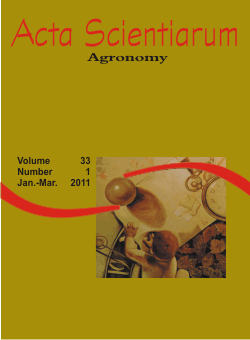<b>Bioecological aspects of <em>Hypocala andremona<em> (Cramer) (Lepidoptera: Noctuidae) on persimmon cultivars</b> - doi: 10.4025/actasciagron.v33i1.5860
Keywords:
Diospyrus sp., biology, oviposition preference
Abstract
The biology of Hypocala andremona (Cramer) on persimmon (Diospyrus kaki L.) leaves of the cultivars Atago and Giombo was studied in laboratory (27 ± 1°C, 65 ± 10% RH, 14 hours photo period) and egg distribution on plants of the cultivar Giombo in a commercial orchard, during the 2001/2002 crop season, in Londrina, Paraná state. The developmental period of larvae fed on ‘Giombo’ was longer (17.8 ± 0.17 days) in comparison to that of larvae fed on ‘Atago’ (15.8 ± 0.27 days). In contrast, the duration of the pupal stage of insects raised on ‘Giombo’ was lower (12.0 ± 0.29 days) than that of insects reared on ‘Atago’ (13.3 ± 0.17 days). The viabilities of larvae were 60.8 and 38.8% for insects reared on ‘Giombo’ and on ‘Atago’, respectively. Pupal viability was similar (ca. 93%) between treatments. The duration of the preoviposition and incubation periods of larvae fed on ‘Atago’ were 4.0 days and 2.1 days, respectively, the fecundity 524.7 eggs, egg viability 77% and adult longevity 12.9 days. No eggs were obtained when H. andremona larvae were reared on ‘Giombo’ in laboratory. Adults preferred to lay their eggs on leaves located at the top of the persimmon tree canopy.Downloads
Download data is not yet available.
Published
2011-02-16
How to Cite
Hohmann, C. L., Meneguim, A. M., & Lovato, L. (2011). <b>Bioecological aspects of <em>Hypocala andremona<em> (Cramer) (Lepidoptera: Noctuidae) on persimmon cultivars</b> - doi: 10.4025/actasciagron.v33i1.5860. Acta Scientiarum. Agronomy, 33(1), 33-35. https://doi.org/10.4025/actasciagron.v33i1.5860
Issue
Section
Crop Protection
DECLARATION OF ORIGINALITY AND COPYRIGHTS
I Declare that current article is original and has not been submitted for publication, in part or in whole, to any other national or international journal.
The copyrights belong exclusively to the authors. Published content is licensed under Creative Commons Attribution 4.0 (CC BY 4.0) guidelines, which allows sharing (copy and distribution of the material in any medium or format) and adaptation (remix, transform, and build upon the material) for any purpose, even commercially, under the terms of attribution.
2.0
2019CiteScore
60th percentile
Powered by 

2.0
2019CiteScore
60th percentile
Powered by 



















































